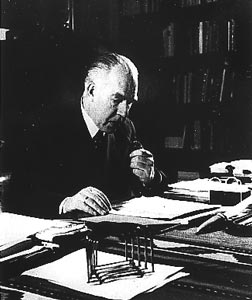The atom – a step towards the infinitely small…
We owe our modern understanding of the atom and its structure to the Danish physicist Niels Bohr. The model he presented in the early years of the 20th Century challenged some of the most fundamental concepts that had gone unquestioned since the days of the Ancient Greeks. For centuries, the atom had been seen as an indivisible unit of matter, the basic building block of everything around us.

Niels Bohr (1885 – 1962)
Father figure of 20th Century Physics, Niels Bohr won the Nobel Prize in 1922. The Copenhagen Institute for Theoretical Physics, which he helped found and directed until 1962, has been responsible for some of the most important developments in quantum theory
© DR
Around 1900, this school of thought was dismissed, in large part thanks to Thomson’s discovery of the electron, the discovery of radioactivity and Rutherford’s experiments on the atomic nucleus. These three findings not only dispelled the concept of the unsplittable atom, but modified the laws of physics deemed to apply to the infinitely small.
According to classical mechanics, electrons orbiting a central nucleus would radiate away energy and eventually collapse into it. Bohr resolved this difficulty in 1913, by postulating the existence of energy levels – to which correspond a limited number of orbits mathematically allowed for the electrons around the nuclei. This model of Bohr’s, later to be refined by Schrödinger’s equation, lays at the heart of all future developments in atomic physics.
The atom was previously imagined as a complete sphere, totally full of matter. In reality and incredibly, the atom is almost entirely made of an empty space. A popular analogy at the time was that the nucleus was like a ‘fly in a cathedral’ – with the electrons at the distance of the walls.
Though slightly inaccurate mathematically, made decades before the real subatomic distances were known, the analogy remains a helpful one in trying to understand the atom. The tiny electrons, travelling at very high speeds, are able to do thousands of rotations around the atom in a very short period of time. As a result, the atom often appears to be full, despite the fact that it is, in reality, largely empty.
The nucleus, a subdivision of the unbreakable atom, is itself made of even smaller particles: nucleons. There are two different types of nucleons; protons and neutrons. Protons and neutrons are identical in size, and are almost two thousand times as heavy as an electron.
The complicated interactions between protons and neutrons, packed together inside the nucleus, can make the resultant nucleus unstable, and cause it to collapse. This ‘nuclear instability’ of some nuclei is responsible for the phenomenon of radioactivity.
When considering any property of atoms or their constituents, we must keep two things in mind. First, their infinitesimal size, and second, their numbers are tremendous. Radioactivity, though it affects us on our large, scales, is ultimately a microscopic phenomenon.
A world with its own laws…
The world of the atom is not only very empty and very small, but has its own physical laws. For instance, the layer structure of the electron orbits is not only very precisely defined, but violates classical physics. To properly understand the way the electrons revolve around the nucleus, as well as the complicated energy levels existing within the nucleus itself, we have to replace the law of ‘classical’ physics, for laws that apply to the world of the very small: Quantum Physics.
Articles on the subject « The atomic world »
The Atom
An almost empty space with mass concentrated in a tiny nucleus The atom is often viewed as a mini[...]
The electron
The best known of elementary particles The electron is an elementary particle that plays a fundam[...]
Atomic Energy Levels
A shell structure …. The conquest of space has familiarized us to the concept of a satellit[...]
Photons
The elementary components of light and electromagnetic waves Light is composed of infinitesimal i[...]
Orders of Magnitude
The very small and the very large … The atom, and the nucleus in particular, belong to the [...]
Avogadro’s Number
Trillions of billions of very small atoms …. The microscopic size of atoms comes with their[...]
E=MC²
The Einstein formula, a relation between mass and energy The energy released by a chemical reacti[...]